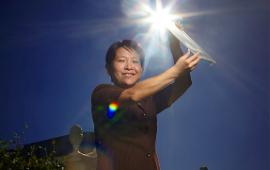A Swinburne professor balances work and family life by being highly organised

In Summary
This article originally featured in Swinburne’s Venture magazine
When Baohua Jia started her first postdoctoral job a decade ago, she found the demands overwhelming. She was leading an international project based at Swinburne’s Centre for MicroPhotonics, co-ordinating 20 researchers across nine universities. And she had a one-year-old daughter.
“I was struggling and thinking about quitting my current profession to find a job that allowed me to better look after my family,” says Professor Jia, whose husband is also a full-time researcher at Swinburne.
Instead, she asked a dozen high achieving female scientists how they managed the juggle. The answer was planning.
These days, Professor Jia prepares a detailed annual plan each December, covering tasks such as team building, priority projects and grant applications.
Each week, she reviews how she’s tracking against the plan and she wakes at 4.30am on workdays to prepare an action list for that day.
“If I do things efficiently for some time, I will book a trip with my family,” she says. My positive attitude helps me to solve this problem and continue working in my beloved research and look after my family.”
Chinese-born Professor Jia migrated to Australia in 2002, after majoring in physics and optics at Nankai University. Her love of physics was ignited in high school, when her teacher showed the class how simple the questions were on an exam that most of them had failed.
“He told us the reason we failed was because we believed it was so hard we couldn’t pass,” she says. “It was a new way of thinking for me; don’t try to find the hard way, use instinct and common sense and the answer can be very simple.”
Professor Jia’s interest in optics was also fortuitous. A mentor urged her to focus on the area, predicting its rise in importance because it is about light and light is energy. She took the advice and completed her PhD in optics at Swinburne in 2006.
Since then, the hard-working Professor Jia has co-authored more than 200 articles and conference presentations and her groundbreaking research has generated more than 500 media reports globally. In the past decade, she’s scooped 30 awards and grants, including a prestigious L’Oreal Australia for Women in Science Fellowship in 2012.
That there are female-only awards is a benefit for women scientists, she says. Plus, there is now a much greater awareness of issues facing women in science, as well as support groups such as SWAN (Swinburne Women’s Academic Network).
“As long as you love it, it is worth the extra effort. If you are able to prioritise and work efficiently, you will find the way,” Professor Jia says.

